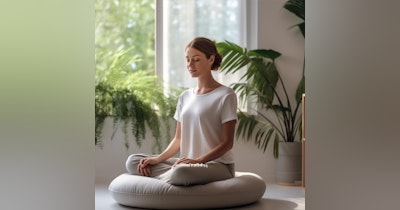If you want to reap the benefits of meditation and acquire a deeper sense of inner peace and mindfulness. Including these steps into your daily routine will help you do so. This is true whether you are new to meditation or have been practicing it for a long time.
GET STARTED TODAY WITHOUT ANY RISK!
Get 7 Days of Unlimited Access Right Now
for Free When You Download Our App!
A life of transformation begins with action. There are seven stages of meditation instruction on a single platform. Live monthly Zoom coaching and training sessions.
Get unlimited free access to the Meditation Life Skills app for 7 days by downloading it now! Visit MeditationLifeSkills.com.
Meditation has become increasingly popular in recent years as people search for ways to reduce stress, improve focus, and enhance their overall well-being.
While many people attend meditation classes or retreats, it's also possible to establish a successful meditation practice at home. In fact, practicing meditation at home can be more convenient, cost-effective, and personalized to your specific needs. However, starting a meditation practice can be intimidating and overwhelming, especially if you're not sure where to begin.
That's why we've compiled a list of 10 simple steps to help you establish a successful meditation practice at home. These steps are designed to be easy to follow and adaptable to your individual preferences and lifestyle.
Benefits of Meditation
Meditation has been practiced for thousands of years and has numerous benefits for both the mind and body. Scientific studies have shown that regular meditation can help reduce stress, anxiety, and depression, lower blood pressure, improve sleep quality, and increase overall well-being.
Meditation can also enhance focus and concentration, increase self-awareness, and improve emotional regulation. By practicing meditation regularly, you can develop a greater sense of inner peace, mindfulness, and compassion for yourself and others.
Understanding the Basics of Meditation
Before beginning your meditation practice, it's essential to understand the basics of meditation. Meditation is a practice of training the mind to focus on the present moment without judgment.
There are several types of meditation, including mindfulness meditation, loving-kindness meditation, and transcendental meditation.
- Mindfulness meditation is one of the most popular forms of meditation and involves focusing on the breath or a specific object while observing thoughts and emotions without judgment.
- Loving-kindness meditation involves cultivating feelings of love and compassion towards oneself and others.
- Transcendental meditation involves using a mantra to achieve a deep state of relaxation and inner peace.
Creating a Comfortable and Peaceful Meditation Space at Home
Creating a comfortable and peaceful meditation space at home is essential for establishing a successful meditation practice. Choose a quiet and clutter-free area in your home where you can meditate without distractions.
You can decorate your meditation space with items that help create a peaceful and calming environment, such as candles, plants, and soft lighting. It's also essential to sit on a comfortable cushion or chair that supports proper posture during meditation. This will help you maintain a relaxed and alert state of mind throughout your practice.
Choosing the Right Time to Meditate
Choosing the right time to meditate is crucial for establishing a consistent meditation practice. It's best to meditate at the same time each day to develop a routine and make meditation a habit.
Many people find that meditating in the morning helps them start their day with a clear and focused mind. Others prefer to meditate in the evening to unwind and relax after a long day. Choose a time that works best for your schedule and allows you to meditate without interruptions.
Selecting the Right Meditation Technique
Selecting the right meditation technique is essential for establishing a successful meditation practice. There are several types of meditation techniques to choose from, including breath awareness, body scan, visualization, and mantra meditation.
Experiment with different techniques to find the one that resonates with you the most. It's also important to remember that there is no right or wrong way to meditate. The goal is to find a technique that helps you focus your mind and cultivate a sense of inner peace.
Breathing Techniques for Meditation
Breathing techniques are an essential aspect of meditation practice. Focusing on the breath can help quiet the mind and bring you into the present moment.
One popular breathing technique is called the 4-7-8 breath. This involves inhaling for four counts, holding the breath for seven counts, and exhaling for eight counts. This technique can help calm the nervous system and induce relaxation.
Another breathing technique is called alternate nostril breathing. This involves inhaling through one nostril and exhaling through the other. This technique can help balance the left and right hemispheres of the brain, promoting a sense of calm and balance.
Tips for Staying Focused During Meditation
When your mind is racing with thoughts and distractions, it can be difficult to maintain concentrate during meditation. This is especially true when you first begin practicing.
Here are some tips to help you stay focused during your meditation practice:
- Set an intention for your meditation practice
- Focus on your breath or a specific object
- Acknowledge and observe your thoughts without judgment
- Label your thoughts as "thinking" and return your focus to your breath
- Use guided meditations or music to help you stay focused
- Practice regularly to improve your concentration and focus
Incorporating Meditation into Your Daily Routine
Incorporating meditation into your daily routine is essential for establishing a consistent meditation practice. Start by setting aside a few minutes each day to meditate.
As you become more comfortable with your practice, you can gradually increase the duration of your meditation sessions.
You can also incorporate meditation into other areas of your daily routine. Such as taking a few mindful breaths before a meal or practicing a short meditation before going to bed.
Maintaining a Consistent Meditation Practice
It is possible that maintaining a consistent meditation practice may be challenging, particularly if one's life is becoming increasingly stressful.
Here are some tips to help you stay motivated and committed to your meditation practice:
- Set realistic goals for your meditation practice
- Practice meditation with a friend or join a meditation group
- Use a meditation app or guided meditation recordings to help you stay on track
- Celebrate small achievements and milestones in your meditation practice
- Remember that meditation is a practice, not a perfect, and be kind to yourself
Conclusion
Establishing a successful meditation practice at home can be a rewarding and life-changing experience. By following these 10 simple steps, you can create a consistent and effective meditation practice that fits your individual needs and lifestyle.
Remember to be patient, kind, and compassionate with yourself as you embark on your meditation journey.
With regular practice, you can experience the numerous benefits of meditation and cultivate a greater sense of inner peace and mindfulness in your daily life.















